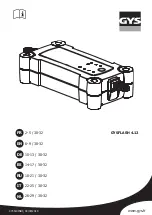
GWFLORID Maintenance Manual
92
Wheel
General tire balancing procedures
Clean out the accumulated dirt and debris from the inside of the rim.
Warning:
The gravel on the tread must be eliminated to avoid flying out and injuring the operator when
undergoing rotational balancing. This is also a good way to acquire better balance. First thoroughly
inspect the tire's damaged condition, then according to the balancing device manufacture's
recommendations, carry out the balancing operation.
Off-vehicle balancing
Most off-vehicle balancers are more accurate and convenient than on-vehicle rotational balancers. They are
also able to perform dynamic (two sided) balancing. Although it does not correct drum brake and brake disc
imbalance like on-vehicle balancing, it achieves the same effect based on its accuracy.
On-vehicle balancing
On-vehicle balancing is different based on equipment and tool manufacturer. Therefore, when performing
balancing operations, be sure to comply to each manufacturer's operating instructions.
Warning: Control the wheel rotation speed to make sure the speedometer stays within 55 km/h.
This restriction is necessary because when a driven wheel slides while the other one stays still, the
speedometer will display only half of the actual wheel speed. When a wheel is sliding, be extremely
careful, because sliding wheels can reach very high speeds. This may lead to the tire rubber peeling
or differential damage, which may cause serious personal injury, or damage to the vehicle.
Tire installation and removal
•
Install or remove tires with a tire changer. When operating machinery, make sure to comply to the machine
manufacturers operation manual. Please do not change tires merely with manual hand tools or tire installation
crowbars. This will damage the tire chafer or the vehicle wheel's rim.
•
Use a wire brush or coarse steel wool to clean off grease and old rubber, as well as light rust or corrosion from
the rim tire bead's tire chafer seat. Before tire installation or removal, first use the indicated tire lubricant to
thoroughly lube the tire chafer portions one time.
•
After installing the tire, inflate it to the specified pressure and make sure the tire bead is properly seated.
Warning: Do not over-inflate the tire. If the tire bead severally expands and exceeds the safety limit,
it may burst and cause serious personal injury. While inflating, do not exceed the specified pressure.
If the specified pressure does not allow the tire bead to sit properly, deflate the tire, re-lubricate, and
then re-inflate.
Spare tire usage
•
Spare tire standard inflation pressure: 420 kPa.
•
Spare tire pressure measurements should be taken under normal temperature conditions.
•
After inflating the spare tire, soapy water should be used to check if the air nozzles core is leaking air, then
lock on the air nozzle cap.
•
The spare tire should always be kept in a useable state. Check the air pressure at least once a month.
•
When the spare tire's working limit, indicated by the remaining pattern's depth, reaches 1.6 mm (and its pat-
tern groove bottom protrudes to the same level), for your safety, please stop using the spare tire.
Caution:
•
The " " symbol on the tire bead of the spare tire in-
dicates the set position of the wear index (shown on
the left).
•
The spare tire's maximum driven speed is 80 km/h,
and maximum distance 200 km per trip.
•
Each vehicle is allowed to use only one spare tire.
•
The spare tire is only used as a temporary backup.
Please go to a professional service station immediately
to get the initial tire repaired or replaced.
Содержание Florid
Страница 1: ......
Страница 3: ......
Страница 31: ...GWFLORID Maintenance Manual 24 Chassis LH side Front Front Upper Lower Unit mm...
Страница 32: ...25 Overall Parameters Chassis Continued LH side Front Unit mm Axis Axis...
Страница 157: ...GWFLORID Maintenance Manual 150 Overall Vehicle s Grounding Point Schematics G01 G02 G03 G04 G05 G06 G07 G08...
Страница 281: ......
















































